

Sand and gravel are used in a many ways to enrich our modern way of life. Sand and gravel in Missouri are categorized as "Construction Sand and Gravel" and "Industrial Sand – St. Peter Sandstone," based on use. The department's Land Reclamation Program regulates sand and gravel mining in Missouri. Visit our Ed Clark Museum of Missouri Geology, where you will find sandstone on display.
-
Construction Sand and Gravel
-
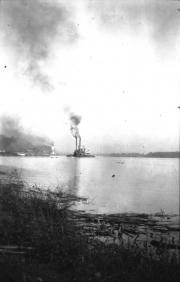
Dredging gravel from the Mississippi River near Hannibal. Commodity

A gravel barge being unloaded near Hannibal. Construction sand and gravel are different size detrital particles or fragments used for building, paving and various other developments. Detrital material consists of particles and fragments detached from pre-existing rocks either by erosion or weathering. Various scales have been developed for describing the different sizes of these particles and fragments (Figure 2). Sand and gravel sizes are utilized in construction while clay and silt (fines) are too small for most construction uses.
Engineers consider sand to be rock or mineral grains with diameters between 0.074 mm (retained on U.S. standard sieve No. 200), and 4.76 mm (passing through U.S. standard sieve No. 4) (Figure 2, ASTM). Geologists consider sand to be a detrital rock fragment or mineral particle smaller then a granule and larger than a coarse silt grain, having a diameter in the range of one-sixteenth to 2 mm (62-2,000 micrometers or 0.0025-0.08 inches, or 4 to -1 phi units, or a size between that of the lower limit of visibility of an individual particle with the unaided eye and that of the head of a small wooden match). Usually, the term sand also is applied to describe a loose aggregate of unlithified mineral and rock particles of sand size; an unconsolidated or moderately consolidated sedimentary deposit consisting of essentially medium-grain detrital particles. The material is most commonly composed of quartz resulting from rock disintegration, and when the term “sand” is used without qualification, a siliceous composition is implied; but the particles may consist of any mineral composition or mixture of rock or mineral fragments, such as “coral sand” consisting of limestone fragments.
Particle Size
Various particle size classifications commonly used by engineers and industry. Gravel is an engineering term for rounded fragments having a diameter in the range of 4.76 mm (retained on U.S. standard sieve No.4) to 76 mm (3 inches). Geologists define gravel as an unconsolidated, natural accumulation of typically rounded rock fragments resulting from erosion, consisting predominantly of particles larger than sand (diameter greater than 2 mm, or one-twelfth inch), such as boulders, cobbles, pebbles, granules or any combination of these fragments; the unconsolidated equivalent of conglomerate rock. It is usually a term used for a loose accumulation of rock fragments, such as detrital sediment associated especially with streams or beaches, composed predominantly of more or less rounded pebbles and small stones, and mixed with sand that may compose 50-80% of the total mass.
Economic Importance
Construction sand and gravel production is an indicator or the overall health of the construction industry and thus an indicator of the state’s overall economy. During the construction boom of the mid 2000s, Missouri produced nearly 17 million short tons of construction sand and gravel during the year 2006, a record. In 2010, Missouri produced nearly 12 million short tons of construction sand and gravel valued at more than $73,000,000.
Composition of Sand and Gravel
Although the gravels and sand of Missouri can vary significantly in their lithological or mineralogical compositions, some generalizations are applicable on a basinal or regional scale.
Missouri River – Higher in lignite than the Mississippi River above its confluence with the Missouri River. Sand fraction primarily composed of quartz. Gravel is predominantly chert.
Mississippi River – Sand fraction primarily composed of quartz. Gravel is predominantly chert. Igneous and metamorphic gravels more common in the Mississippi than the Missouri River. Floodplain gravels are rounded to subangular above the confluence with the Missouri River.
Ozarks – Chert gravels are the dominant commodity from Ozark streams and rivers. Some quartz sand can be found in streams where Ordovician sandstones (e.g., St. Peter Sandstone) are exposed. In the St. Francois Mountains, large percentages of granite, felsite and mafic gravel are present.
Glacial Till Plains of northern Missouri – North of the Missouri River, glacial drift up to 400 feet is present. Sand size ranges from fine to coarse with the majority being medium to coarse. The sand is predominantly quartz. The lithology of the gravels varies significantly. The gravels consist of chert, limestone, quartzite, granite and mafic rocks. The majority of the sand and gravels are in a clay matrix that is easily removed by washing.Southeast Missouri Lowlands – The “Lafayette” gravels that mantle Crowley’s Ridge are the primary source of gravel in this region. Sand is produced from the Tertiary age Holly Springs Formation. These deposits consist of interbedded gravel, sand and clay deposits. The gravel is typically a brown chert. The sand is principally quartz being dominantly medium to coarse size.
Occurrence

Current construction sand and gravel production in Missouri. Economic deposits of construction sand and gravel primarily occur in the channels and flood plains of rivers and streams. Major producing basins in Missouri include the Missouri, Mississippi and Meramec rivers. Currently, 58 of 114 Missouri's counties are active producers of construction sand and gravel (Figure 3).
Primary Uses
Construction sand and gravel have many uses, past and present. The most common uses are listed below.
- Sand for Mortar
- Plastering
- Bricklaying
- Stone Masonry
- Sand and Gravel for Concrete Aggregate
- Roofing Gravel
- Sand for the Manufacture of Sand-Lime Brick
- Paving Sand
- Sand and Gravel for Pavement Foundations (Road Base)
- Sand for the Cushion Layer
- Sand for Asphalt Pavements
- Gravel for Roads
- Road Aggregate/Metal
- Rural Roads
- Gravel for Railroad Ballast
- Historical Production

Historical construction sand and gravel production in Missouri. 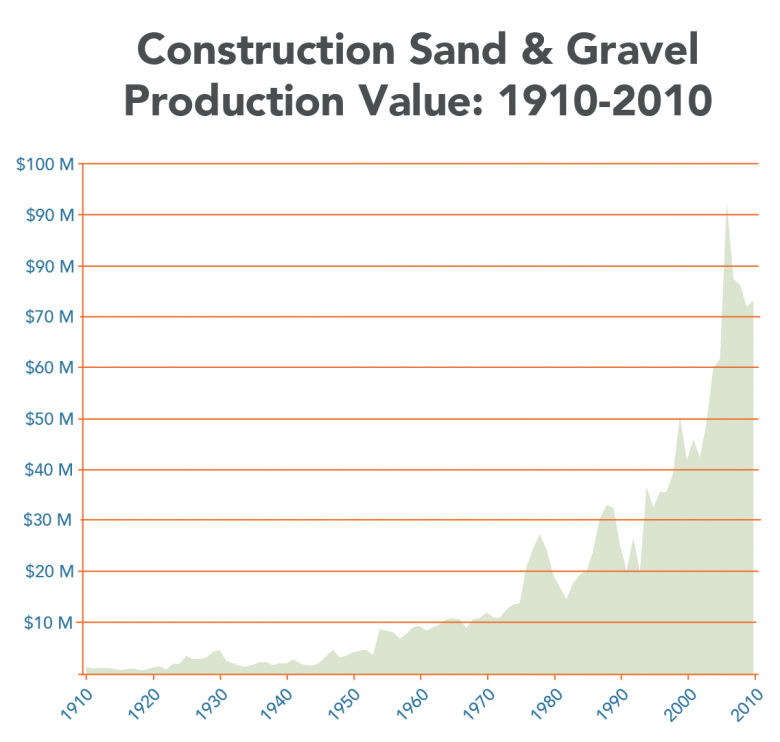
Historical value of construction sand and gravel produced in Missouri. Values have not been adjusted to account for inflation. Construction sand and gravel have been used on a local basis since before Missouri became a U.S. state. Historically, the cumulative total product of the greater St. Louis area (St. Louis County and City, Jefferson, Franklin and St. Charles counties) accounts for nearly 70% of the state’s total sand and gravel production (including industrial sand). In this region, gravel is principally mined from the Meramec basin. Sand is produced commonly from the Missouri and Mississippi rivers. This area still accounts for the majority of sand and gravel produced in the state. Principal producers in the greater St. Louis area include Fred Weber Inc., Lafarge NA, Simpson Sand & Gravel Inc., St. Charles Sand Company and Winter Bros. Material Company. Other principal producers in the state include Holliday Sand & Gravel and Mid America Sand LLC.
Common Terms Used in the Construction Sand and Gravel Industry
- Fill (engineering) – (a) Man-made deposits of natural earth materials (e.g., rock, soil, gravel) and waste materials (e.g., tailings or spoil from dredging), used to fill an enclosed space such as an old stope or chamber in a mine, to extend shore land into a lake or bay, or in building dams. (b) Soil or loose rock used to raise the surface of low-lying land, such as an embankment to fill a hollow or ravine in railroad construction. Also, the place filled by such an embankment. (c) The depth to which material is to be placed to bring the surface to a predetermined grade.
- Fill (geological) – Any sediment deposited by any agent to fill or partially fill a valley, sink, or other depression.
- Building Sand – Sand used in erecting buildings, particularly used for making mortar and wall plaster.
- Paving Sand – A type of commercial sand that is divided into three general usage classes; concrete pavements, asphaltic pavements, and grouting sand. Sand for concrete pavements according to the U.S. Bureau of Public Roads, should all pass a one-quarter inch screen, 5 to 25% should be retained on a No. 10 sieve, from 50 to 90% should be retained on a No. 50 sieve, and not more than 10% should pass through a No. 100 sieve. Not more than 3% of the weight should be matter removable by elutriation. For asphaltic pavement, small amounts of organic matter are not objectionable in the sand. All should pass a one-quarter inch screen, 95-100% through a No. 10 sieve, 80% through a No. 20 sieve, and 5% through a No. 200 sieve.
- Concrete Aggregate – Normal concrete aggregate includes sand, gravel, crushed rock of various types and slag. The nomenclature is given in British Standards, 812. The mineralogical composition is dealt with in American Society for Testing and Materials, C294 and C295.
- Road Metal – Also called road aggregate, this rock is suitable for surfacing roads and for foundations, asphalt and concrete roadways; also used without asphaltic binder as the traffic-bearing surface, generally on secondary roads.
- Roofing Granule – A particle of rock or fired clay approximately No. 9 mesh, used to manufacture roofing shingles.
- Roofing Gravel – Gravel placed over asphaltic roofing material, especially buildings with flat roofs. The gravel helps keep tar and other asphaltic roofing materials from melting and cracking and thus leaking.
- Gunite Sand – A mixture of sand and cement, sprayed with a pressure gun onto roofs and ribs to act as a sealing agent to prevent erosion by air and moisture.

Historical price per short ton of construction sand and gravel produced in Missouri. Values have not been adjusted to account for inflation.
References and Further Reading
Dake, C.L., 1918, The sand and gravel resources of Missouri, Missouri Bureau of Geology and Mines, vol 15, 2nd series, 274p.
Neuendorf, K.K., Mehl Jr., James P., and Jackson, J.A. (Editors), 2011 Glossary of geology. American Geosciences Institute, Alexandria, VA, 783p.
Thrush, Paul W. (editor), 1968, A dictionary of mining, mineral, and related terms, U.S. Dept. of the Interior, Bureau of Mines, Washington D.C., 1269p.
Search the Missouri Geology Bibliography.
Limestone is on display in our Ed Clark Museum of Missouri Geology.
The department's Land Reclamation Program regulates sand and gravel mining in Missouri.
-
Industrial Sand
-
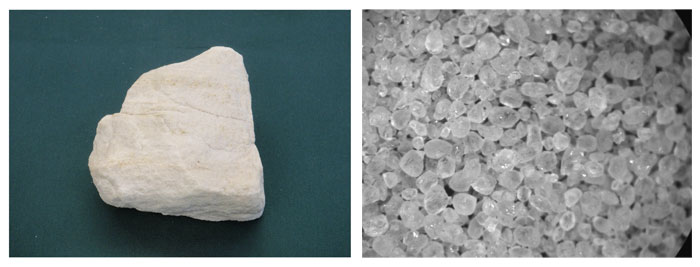
Left: St. Peter Sandstone hand sample is four inches across.. Right: St. Peter sand grains (20x magnification), from Pacific, Missouri. Commodity - St. Peter Sandstone
Mineral and Chemical Composition: St. Peter Sandstone is composed almost entirely of silica, otherwise known as silicon dioxide (SiO2) or quartz. In Missouri, the silica content is typically not less than 96%, with many areas higher than 99%. The iron oxide content is often less than 0.1%. The following table is an average chemical composition (weight percent composition) of 22 unwashed samples from different locations in Missouri (Dake, 1918).
Average chemical composition of 22 unwashed samples from different locations in Missouri
SiO2 Fe2O3 Al2O3 CaO MgO LOI Total 98.88 0.19 0.35 0.13 0.11 0.34 100 Economic Importance Economic Importance
St. Peter Sandstone is used in a variety of ways that enrich the modern way of life. It has been produced in Missouri for the last 140 years. More than 65 million short tons of St. Peter, having an estimated present value of $2 billion, have been mined in Missouri from the 1870s to present. In 2008, more than 700,000 short tons of St. Peter at a value in excess of $20 million were produced from Missouri. St. Peter Sandstone was originally used for the manufacture of glass. Its dominant use recently has been as a proppant in oil and gas formation stimulation nationwide. There is an estimated 3.8 trillion short tons of St. Peter Sandstone reserves in Missouri.
Occurrence
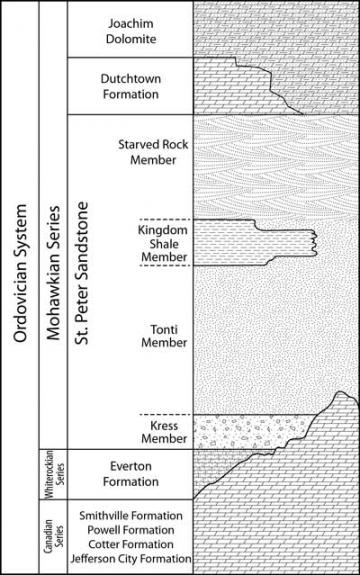
The St. Peter Sandstone in Missouri belongs to the Mohawkian Series of the Ordovician System and comprises our members, and are listed from top to bottom: Starved Rock Member, Kingdom Shale Member, Tonti Member, Kress Member. The St. Peter is continuously present in the subsurface in the northern half of the state and the southeastern edge of the state. The St. Peter crops out (occurs at the surface) in a narrow band that starts in western Montgomery County and runs southeastward, along the Missouri River, to just west of St. Louis and continues south, just west of the Mississippi River, through Scott County. The outcrop width varies from less than one mile wide to over 10 miles wide, and spans more than 150 miles in length. The formation dips into the subsurface radially away from the outcrop band. A notable isolated outcrop occurs in Lincoln County to the north of the main outcrop band. The St. Peter is discontinuously present in the subsurface along a band in the central western portion of the state. The St. Peter is not present at the surface or in subsurface in the remainder of the state. The formation averages 80–100 feet thick.
St. Peter Sandstone Generalized Map
Detailed St. Peter Sandstone mineral resource characterization maps are available for purchase from the department's Missouri Geological Survey. Visit our publications counter at 111 Fairgrounds Road in Rolla, or call 573-368-2100.
- OFM-11-594-GS: Structure Contour Map on top of St. Peter Sandstone Mineral Resource in Missouri
- OFM-11-595-GS: Isochore (Drill Thickness) Map of St. Peter Sandstone Mineral Resource in Missouri
- OFM-11-596-GS: Overburden Thickness Map above St. Peter Sandstone Mineral Resource in Missouri
Primary Use
St. Peter Sandstone has been dominantly used for glass manufacturing since first being mined. The high silica content and subsequent lack of impurities make it ideal for use as glass sand. More recently, it is rapidly being utilized as a proppant in hydraulic fracturing to enhance oil and gas extraction. It is employed when a rock formation beneath the surface is hydraulically fractured to create or improve the flow of natural gas and oil to wells. The sand is pumped into the fractures to hold them open, thus increasing the yield from wells.
Other Uses of St. Peter Sandstone
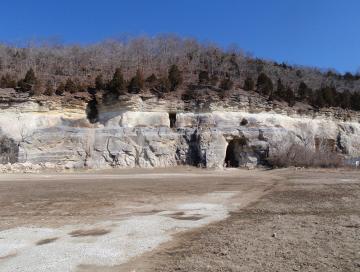
St. Peter Sandstone abandoned mining location in Pacific, Missouri. - Refractory material — used as foundry sand, molding sand and core sand.
- Abrasive — used for polishing compounds, grinding compounds, stone sawing and blasting sand.
- Metallurgical silica — used as a component in the preparation of silicon alloys and as a flux.
- Finely ground silica:
- Ceramic industry — used in whiteware, earthenware, chinaware and glazed wall tile.
- Chemical industry — used in the manufacture of soluble silicates and silicon carbide.
- Used as an additive in paint, adhesives and investment castings.
- Used as an anti-caking agent in table salt.
- Catalytic converters — used to filter exhaust particulates.
- Engine sand — used to improve locomotive traction on slippery rails.
- Filter media — used in drinking water purification and wastewater treatment.
- Filler material — used due to its relatively inert chemical properties.
- Desiccant — in the form of silica gel.
- Properties: The St. Peter Sandstone is typically a well-sorted, friable, ultra-pure, fine-to medium-grained, quartzose sandstone with silica content higher than 99 weight percent in places. The sand grains are rounded, highly spherical and characteristically frosted. They typically vary in size from two millimeters (No. 10 U.S. Standard Sieve Series size) to less than 0.075 millimeters (No. 200 U.S. Standard Sieve Series size). Bedding is indistinct, and the formation appears massive throughout. The rock is cross-bedded and ripple-marked locally. The formation is generally porous, permeable and mostly nonfossiliferous in Missouri
Color
- White, with occasional shades of pink and green. Weathered surfaces are a dirty gray or brown and are case-hardened at many localities.
- Hardness: Individual sand grains are hard, seven on Mohs scale.
- Cementation: Soft, friable, easily disaggregated.
- Specific Gravity: Estimated 2.24 assuming 15% porosity (S.G. of quartz is 2.65).
Porosity
Estimated 10 - 15%
Solubility
Quartz has a very low solubility under normal conditions, thus St. Peter Sandstone is stable in ordinary situations. The solubility of quartz increases rapidly when pH exceeds nine. Quartz is insoluble in acids except hydrofluoric.
Stratigraphic Column
General Geology: The St. Peter Sandstone in Missouri belongs to the Mohawkian Series of the Ordovician System and comprises the following four members, listed from top to bottom:
- Starved Rock Member
- Kingdom Shale Member
- Tonti Member
- Kress Member
Not all of the members are present in the St. Peter throughout its distribution. In southeastern Missouri the Tonti member of the St. Peter rests, possibly conformably, on the Everton, and is conformably overlain by the Joachim Dolomite. North of Jefferson County, the Kress Member (“detrital zone”) is disconformable on the eroded surface of the Ibexian (Canadian) Series strata. In some parts of the subsurface of northern Missouri two members, the Starved Rock Member and Tonti Member are present and sometimes separated by the Kingdom Shale Member. The Starved Rock is an elongate barrier bar sequence, oriented northeast to southwest, overlying the more wide-spread “sheet-sand” of the Tonti Member. The depositional environment of the St. Peter is much debated. It has characteristics of both eolian and marine origin. It is likely a combination of both, beginning as a massive dune field that was overtaken and reworked by a marine transgression (that is, transgressive barrier bar sequence) and transformed into a series of offshore bar deposits, oriented northeast to southwest.
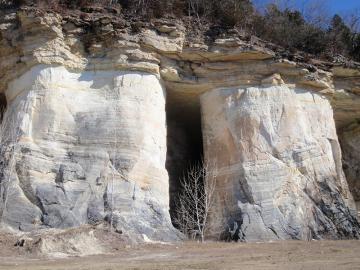
St. Peter Sandstone abandoned mining location in Pacific, Missouri. Mining
The St. Peter Sandstone was first mined in Missouri in the 1870s for glass sand. Early mining was conducted at the surface and underground, and was concentrated near the town of Pacific. Presently (2012) there are four companies producing St. Peter in Missouri. These sites are located in eastern and southeastern Missouri along the St. Peter outcrop band. Current production is from surface quarries using controlled blasting at the quarry face to break the sandstone into pieces. It is then disaggregated by crushing or high pressure water-jet. The product is then washed, separated and dried by various methods depending on desired end product.
Production History
- Recorded production of silica sand (St. Peter Sandstone) began in 1910.
- Missouri’s highest annual production was in 1974, at 1.4 million short tons.
- Cumulate production of St. Peter is now greater than 65 million short tons, with an estimated present value of $2 billion.
- St. Peter Sandstone Production.

Cumulate production of silica sand in Missouri from 1900 to 2016 was 80 million short tons with an estimated percent value of $3.5 billion. References and Additional Reading
Missouri Geology Bibliography: Search the electronic bibliography, published by the Missouri Geological Survey and predecessor agencies, contains references from 1804 to present.
Chemical composition data adapted from the following reference:
- Dake, C.L., 1918, The sand and gravel resources of Missouri: Missouri Bureau of Geology and Mines, Volume 15 (2nd Series), 274 p.
Lithologic and stratigraphic descriptions adapted from the following references:
- Thompson, Thomas L., 1991, Paleozoic Succession in Missouri, Part 2 – Ordovician System: Missouri Department of Natural Resources, Missouri Geological Survey, Report of Investigations 70 Part 2, 202 p., 163 figs.
- Thompson, Thomas L., 1995, The Stratigraphic Succession in Missouri (Revised 1995): Missouri Department of Natural Resources, Missouri Geological Survey, Volume 40 (2nd Series) Revised, 188 p., 42 figs., and 1 tbl.
Search the Missouri Geology Bibliography.
Limestone is on display in our Ed Clark Museum of Missouri Geology.
The department's Land Reclamation Program regulates sand and gravel mining in Missouri.

